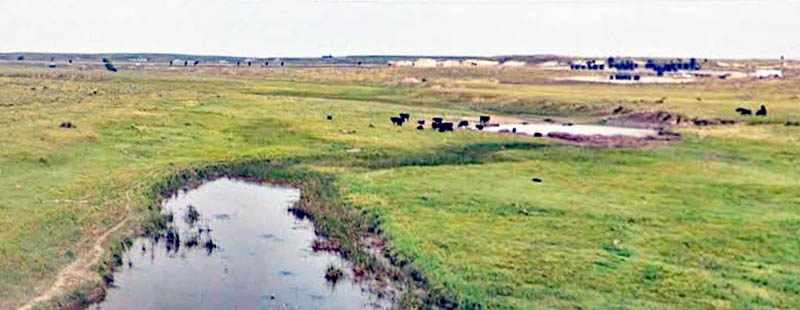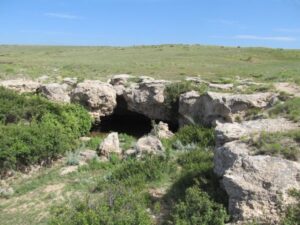
Ladder Creek in Logan County, Kansas, courtesy of Google Maps.
Ladder Creek, a tributary of the Smoky Hill River, is a 230-mile-long stream in the central Great Plains that flows from eastern Colorado into western Kansas.
Ladder Creek, also known locally as Beaver Creek, was named by a survey party that found a ladder embedded in the grass by the creek. When they tried to pull it out, it broke into pieces. As a result, the survey crew called the stream Ladder Creek.”
Ladder Creek rises just south of Firstview, Colorado, in central Cheyenne County in the far eastern part of the state. It then flows east into western Kansas, turning southeast in southern Wallace County and then east again in north-central Wichita County. Finally, in Scott County, it turns north and joins the Smoky Hill River at Elkader, Kansas, in southwestern Logan County. Ladder Creek has a narrow valley and poorly developed terraces in its lower reaches. Other streams in the area flow generally eastward. All the streams have short, narrow tributaries, generally normal to the central valley.
In 1664, a group of Taos Indians fleeing Spanish rule built a small pueblo on the west bank of Ladder Creek in what is today north-central Scott County, Kansas. The site was occupied intermittently until it was finally abandoned in 1727. University of Kansas archaeologists excavated the site in the 1890s, and it became known as El Quartelejo, the northernmost pueblo ruins in the United States.
In September 1878, the U.S. Army fought the Northern Cheyenne in the Battle of Punished Woman Fork on bluffs overlooking the creek a few miles south of El Cuartelejo. Earlier that year, a group of Northern Cheyenne, led by Chiefs Dull Knife and Little Wolf, escaped their reservation at Fort El Reno, Oklahoma, and headed north through Kansas toward their former home. The Cheyenne group consisted of 92 warriors, 120 women, and 141 children. Lieutenant-Colonel William H. Lewis, commander at Fort Dodge, was dispatched to capture and return them. On September 27, 1878, Lewis and his troops located them. The women, children, and elderly took cover in Squaw’s Den Cave as the warriors fought the U.S. soldiers, at which time Lewis was shot in his thigh. Later that night, the Cheyenne escaped in a northwest direction. Lewis died of his wounds the next day, becoming the last Kansas military casualty of the American Indian Wars.
In 1928, the Government of Kansas acquired El Cuartelejo and the surrounding land to create a state park. The following year, it dammed Ladder Creek a few miles north of the ruins to create Lake Scott, and the park became known as Lake Scott State Park.
©Kathy Alexander/Legends of America, updated October 2025.
Also See:
Sources:

